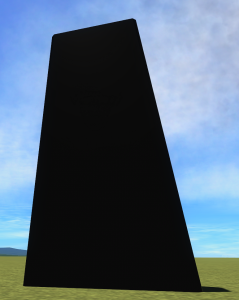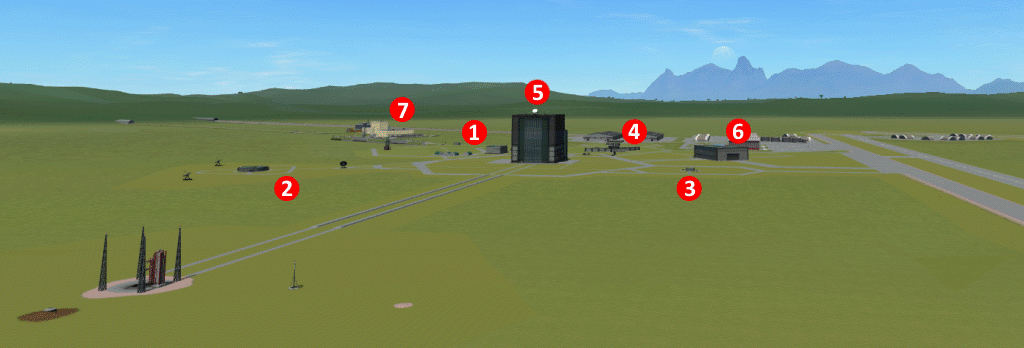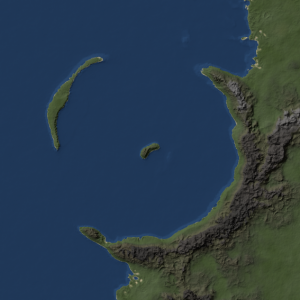General
The Kerbal Space Agency is a project dedicated to realism both in how things are played in Kerbal Space Program and how things are presented to you, the audience.
Realistic Playstyle
The “real world” here is Kerbin, not Earth, and reality applies to the kerbal world as opposed to how things behave in the Earth world. For example, re-entry into Earth’s larger atmosphere provides a significantly greater challenge relative to re-entry in Kerbin’s smaller atmosphere, and the physics of the game are not changed to make Kerbin more like Earth. Kerbin is Kerbin. A slight diversion is while orbital mechanics for vessels and celestial bodies are based on KSP’s default 2-body physics simulation, n-body physics behavior is also sometimes taken into account for story purposes.
Additional aspects of reality that affect the gameplay and thus the story include but are not limited to: the speed of light is properly calculated when determining signal delay between vessels; Kerbals that die stay dead, and kerbals that survive horrific crashes end up injured; Some rocket engines may only have a limited number of restarts; Cryogenic fuel boils off; Radiation is a serious concern; Life support is required for crewed missions; Rockets take time to build, roll out, launch and be recovered; Technology is gained and applied gradually over time.
Realistic Presentation
All the actions and events that occur throughout the KSA’s history are presented to you as if they are actually happening at any given time (see the FAQ tab above for more on the use of Earth time). Largely through this website, @KSA_MissionCtrl and the Operations Tracker, you are able to immerse yourself in the regular operations of the Agency and keep tabs on what is happening. These operations are all supported by numerous materials including vessel blueprints, surface maps, visualizations, info-graphics, telemetry data, on-board camera images, videos and more, dispersed through our various media channels (see icons at top of page on desktop browsers)
While other players prefer to use YouTube or livestreams on Twitch or convert their missions to stories or graphic novels, the KSA is presented in the style of actual space agencies like NASA, ESA, CSA, JAXA, etc. While it’s possible to see much of their operations in person, the majority of people see only what is shown via the agency’s various media outlets, as it is with the KSA. Such operations will be carried out following much of the same procedures and guidelines put in place by actual agencies. You may very well forget that this is all happening based on a game.
History
A Brief History of Kerbin & Kerbal Society
years ago (1746 AD Earth time) Kerbin was populated across the world by both primitive and advanced societies, some of which were at various states of war with one another. While combustion engines and propellers powered various forms of transportation (dirigibles, boats, cars), jet turbines, fixed-wing aircraft and atomic power had yet to be fully realized by any society and no one had any want or need to travel into space when so much of Kerbin lay unexplored. Most societies did not even bother studying the vast universe above them. This all led to no one having any clue a roughly 7km-wide asteroid was bearing down on the planet. It sliced through the thin atmosphere and slammed into the edge of a continent, forming a crater about 175km in diameter and bringing about the onset of a global extinction.
The more advanced societies that survived the initial impact were able to band together and begin frantically tunneling underground to survive the coming nuclear winter and toxic atmosphere created by all the volcanic eruptions triggered after the impact. Anyone and anything left on the surface was dead within 20 years, leaving behind only the hardiest of bacteria and other basic life forms. For just over 200 years kerbals survived underground with all they could collect and preserve from the surface stored in genetic vaults. The fact that kerbal society in any form was able to survive at all was due largely to the ingenious work of the scientist Joonhuff Kerman, whose surname is now adopted by all adult kerbals as a sign of unity.
The ability to live on the surface returned years ago (1971 AD Earth time), and although every one of the descendants of the original underground colonists relish the ability to walk out under the sun and through the vast wilderness that has regrown since the impact, a deeply-ingrained fear of the sky above keeps the majority of society below ground even to this day. However it also bolstered a desire to know more about what happens above the surface of Kerbin, and whether another space rock is on its way at some point. The fields of astronomy, astrophysics and cosmology have grown by leaps and bounds over the last several generations from observatories built into mountains and as the vastness of the universe opened up, kerbal society grew even more tightly knit.
A History of the Kerbal Space Agency
years ago (2014 AD Earth time) came the discovery of The Monolith, which spurred the entire kerbal population to seek out life among the stars. An entrepreneurial kerbal by the name of Drew Kerman began gathering up the brightest minds in various fields related to rocketry and spaceflight in order to form an agency with the mandate of exploring and observing the space around and beyond Kerbin. It was not until late 2016 that everything was in place to officially form the Kerbal Space Agency. Surprisingly, the most difficult part was the surface facilities that would need to be constructed to house the space program – no one had built structures on the surface for so long it was almost a lost art. With the end of construction for the Kerbal Space Center, the KSA began operations to formulate and carry out its strategy for conquering the void above and beyond while the rest of kerbal society began to repopulate the surface in support.
Simultaneous to the onset of KSA operations came along the Asteroid Tracking Network, as technology behind telescopes was finally getting to the point of being able to detect small rocky bodies like the one that had nearly wiped kerbal civilization out of existence. Although some notice of large asteroids had been declared in years past, they were simply fortuitous discoveries and no one had been able to dedicate resources to either properly document their orbits or go looking for smaller rocks that didn’t reflect much light. The ATN has spread the workload out among several telescopes operated by educational institutions and the Kerbal Astronomical Society but relies largely on amateur astronomers, more and more of whom are making trips to the surface with personal scopes that can spot asteroids as the technology becomes more widespread and cheaper.
Latest summaries of events transpiring at the Kerbal Space Agency:
Show Recent Ops Summaries- Operations Summary – Weeks of 2/1 & 2/8/21
February 12, 2021
- Operations Summary – Weeks of 1/18 & 1/25/21
January 29, 2021
- Operations Summary – Weeks of 1/4 & 1/11/21
January 15, 2021
- Operations Summary – Weeks of 12/7 & 12/14/20
December 18, 2020
- Operations Summary – Weeks of 11/23 & 11/30/20
December 4, 2020
The Monolith
 Over the years since the surface became habitable once again adventurous kerbals have set forth from the underground caverns to explore the new surface world. No one was expecting to find an unnatural object on the surface of Kerbin after more than 200 years following a global cataclysm and yet one of the explorers stumbled across this mysterious artifact on the shores of the Kerblantic ocean.
Over the years since the surface became habitable once again adventurous kerbals have set forth from the underground caverns to explore the new surface world. No one was expecting to find an unnatural object on the surface of Kerbin after more than 200 years following a global cataclysm and yet one of the explorers stumbled across this mysterious artifact on the shores of the Kerblantic ocean.
The monolith appears to be embedded deep into the ground, as all attempts to move it have failed and trying to excavate it produced an unsettling tremble deep in the body of kerbals in the area. This prompted further study into the object’s apparent ability to sense its surroundings, but no further reaction could be elicited. Other than the fact that it did not want to be moved, the monolith gave up no further clues as to its purpose.
Although the object remains an enigma, the population of Kerbin have little doubt that it was placed there by some form of advance intelligence in the centuries since the asteroid impact. The object and what it could mean for other life in the galaxy has spurred the kerbal society to begin their own journey to the stars. The location of the object was deemed to not be a coincidence, situated at a perfect spot from which to launch rockets into orbit. A facility for doing that and more was constructed on the same land.
Various studies of the monolith remain ongoing at the nearby KSC, and any updates from them can be reviewed below.
Show Recent News- Operations Summary – Weeks of 11/9 & 11/16/20
November 20, 2020
Expedition to Find ExilesCrystals Allow Capacitor Breakthrough - Operations Summary – Weeks of 9/14 & 9/21/20
September 25, 2020
- Operations Summary – Week of 3/23/20
March 27, 2020
Chikelu Confirmed Missing After Initial Denials - Operations Summary – Week of 12/9/19
December 13, 2019
Major Break in KSC Attack Investigation - Operations Summary – Week of 11/18/19
November 22, 2019
ASA Official Report on Deuce Attack Released
Monolith Updates – Curated tweets by KSA_MissionCtrl
KSC Information
 The Kerbal Space Center, the first surface complex to be built in over 200 years, houses facilities for the research, development, management, construction, control and launch of rockets and aircraft for the purposes of exploring both the surface of Kerbin and space beyond the atmosphere. Employees are also housed within the space center and its satellite community buildings, which provide additional support for surface operations. A single access road provides a link to the nearest underground city. Public access to the KSC is currently restricted while focus remains on getting the various programs off the ground and operating efficiently.
The Kerbal Space Center, the first surface complex to be built in over 200 years, houses facilities for the research, development, management, construction, control and launch of rockets and aircraft for the purposes of exploring both the surface of Kerbin and space beyond the atmosphere. Employees are also housed within the space center and its satellite community buildings, which provide additional support for surface operations. A single access road provides a link to the nearest underground city. Public access to the KSC is currently restricted while focus remains on getting the various programs off the ground and operating efficiently.
[1] Research & Development
The KSC has several buildings dedicated to testing new technologies and evaluating data returned from missions. Scientists at work here are among the best on the planet at what they do, covering disciplines from biology to astronomy to meteorology and more. The R&D department’s focus and overall mandate is lead by the enigmatic Wernher Von Kerman, although the day-to-day operations are overseen by the energetic Lead Scientist Cheranne Kerman.
[2] Tracking Station
Engineers coordinate & monitor any active mission vessels from this building, as well as maintain communications using the two dishes available. These 6m diameter dishes can receive hi-gain signals easily from Kerbin orbit and clear out to Minmus. Beyond the Kerbin system these dishes can only collect enough radio waves to support lo-gain signal reception.
[3] Launch Control
Set well back from the launch pad (which does sport a nearby bunker for any adventurous kerbs and sensitive science equipment) sits the launch control building, domain of Flight Director Lanalye Kerman and her team. All vehicles launched from the KSC are controlled from here during their roll-out, pre-flight, launch and initial ascent before being handed over to the tracking station.
[4] Administration Complex
These buildings house the majority of KSA staff as well as the current crop of astronauts and largely handle the day-to-day operations of the KSC. They include the offices of Operations Director Drew Kerman and Head of Finances Mortimer Kerman.
[5] Vertical Assembly Building
Standing an impressive 67m, this is currently the tallest known unnatural structure on the entire surface of Kerbin and can handle the construction of vehicles as tall as 50m and as wide as 22m in diameter. We hear the views from the top are pretty awesome. The Ascension program makes use of this space to construct its large rockets.
[6] Horizontal Assembly Building
This second construction facility, originally designed for aircraft, is able to support vehicles only as high as 15m but with a length of 58m and a width of 40m (although vehicles wider than 17.5m will need disassembly to make it through the doors). Both this and the VAB are managed by Lead Engineer Simon Kerman. The HAB as of late 2020 is now used to construct smaller rockets for the Progenitor program
[7] Support Village
To help support operations on the surface, supplies and additional personnel are housed slightly off-site in the nearby support village, which is connected to the nearest underground city via road. It also provides a security checkpoint for access to the KSC.
KSA Staff
Character art by Yorshee
FAQ
#1 Why do you use Earth time (days/months/years)?
There’s no real point in making people have to learn a different time system when they are trying to follow along with ongoing operations. Being able to split events into days/weeks/month/years that people already comprehend just makes everything easier to follow. A lot of what we do can be followed online via our Operations Tracker, where you can watch launches, maneuvers and see the craft move, so it’s important that people have a good understanding of when things are happening if they want to watch. There are numerous in-jokes made about the kerbals using a system of time that has no relation to their planet. Hey how do they even speak English?
#2 How does the Ops Tracker work?
A common misconception about the Operations Tracker is that it’s pulling data from an always-running copy of KSP similar to how web-based telemetry mods like Telemachus operate. The Operations Tracker however is not a real-time system, it’s just simulating a real-time system. Data for vessels and bodies are stored in states that are stamped with a specific time they are valid in seconds since the start of the game. When you view the Operations Tracker it pulls up the previous state of the vessel/body nearest to the current time you are viewing and extrapolates any data it needs from that point on. This is similar to how the game actually works – if you view your SFS save file you will see the last state your vessels were in and when you load the game it uses those values to calculate where in orbit the vessel should be for the current point in time and how it should travel from there.
The actual technology behind the Operations Tracker is a rather horrible mash of Javascript and ASP tied to MsAccess databases (see the Github repository for details). It’s not pretty, but the author was never really a web developer, and it all seems to work okay.
#3 Is the game actually played in real time?
No. Events are fed to you, the audience, in real time but the game itself takes full advantage of time warp wherever possible. If 4 in-game days pass in the span of a real day, then it will be 4 real days before those events are made fully available to the audience. In fact a lead time of 1-3 months is generally in place so the author can take time off if needed without having to interrupt any ongoing KSA events. Usually.
#4 What type of game mode is KSP played in?
Career mode is used, however it is modified to allow the KSA to develop in its own way rather than strictly by how the game decides career saves should progress.
#5 What mods are used by the KSA?
You can find the full listing of mods in use and various notes about their use in our Mod Installation Log.
#6 Why is the sun yellow in space and not white?
We see a white sun in space because of how hot it is, and a yellow sun from Earth due to scattering in the atmosphere. Kerbol (known in the game as The Sun but we prefer Kerbol) is smaller and cooler, so it appears yellow from space. It should probably appear a slightly different color when viewed from Kerbin but due to game engine limitations that’s not possible for now.
#7 Is there actual weather in the game?
Sadly, no. Several attempts have been made by modders to introduce weather but none have been completed. However consideration is given to what the weather could or should be like, and is simulated as best as possible with what options are available. For example rainy days don’t actually cause rain to happen in the game, but anything that would be affected by the rain like aircraft simply don’t fly missions. Weather is mentioned a lot in our tweets because it brings about more variation in missions, but any wind/rain/etc is not affecting anything in the game itself (although missions are still played as if they are as best as possible). Foggy or overcast days are done by changing the altitude/density of the clouds, and cloud altitudes can be changed to be low or high depending on what the plot requires to keep things interesting. There is one instance of actual game weather – the clouds do move while the game is running, so sky conditions change dynamically. This is sometimes used to determine if/when missions that rely on clear skies are launched or not. Other times it is a plot decision.
#8 How many people work on this project?
Just one. He has no life. However a lot of what is used by the KSA in all aspects are also assisted by the KSP community in general in the form of ideas, mods, code libraries, graphics, etc.
#9 Will the KSA ever share universe with other twitter accounts?
No. Maintaining a shared universe across more than one hobbyist project generally is not a good idea, and too much extra work would need to go into planning to keep things working together. It’s been tried to various extents in the past, so this is not just a belief but a proven fact. You can still follow other interesting KSP space agencies on twitter.
#10 Will the KSA explore the entire solar system and colonize most of it?
Eventually, yes.
#11 How long will this take?
Years. Real-world years. Hopefully the KSP community will still be around, but if not hopefully everyone who has stopped playing or just burned out from playing will still enjoy following along.
#12 Why is it taking so long to get to space (kerbed missions, stations, other planets, etc)?
Because space is hard? But really though, it is, and part of the aim for this project is to reflect that, and also reflect the effort that real-world space agencies put in, through the billions of hours worked by their thousands of employees. When I finally send a probe to another planet after a few actual years, I hope to feel just a small slice of what actual spacecraft mission participants have had to endure to get their missions to their destinations (and I don’t just mean travel time – did you know New Horizons took over a decade of work just to get to the launch pad?). There is also the fact that KSP is still a very actively-developed game both from the actual game makers and the modding community, which means the longer it takes for KSA to do something the better it will look. Finally, taking everything slow lets me, the sole project owner, actually handle it all without getting overwhelmed as more and more operations begin to take place over time.
#13 Could you burn out?
That’s very possible, hopefully it won’t happen. But if it does, it probably won’t be anyone’s fault but my own for working too hard
#14 Will the KSA visit other star systems?
Eventually, yes. That will take even longer – although the advent of some form of FTL technology will likely come about to help.
#15 What can I do to support the KSA?
Be active and responsive – I love interacting with people on twitter. Comments and feedback can also be submitted here on the website as well as stuff posted on reddit and the KSP forums. Seeing people take interest and participate is very rewarding.
Terminology
Here is a glossary of acronyms, abbreviations, symbols and terms that are used by the Kerbal Space Agency. When you see [] anything within them is optionally included, with numerous options separated by /. * is a wildcard character that can be replaced by any letter and # is a wildcard character that can be replaced by any number. Anything in () refers to an alternate way of writing the term.
Symbols-C
Show TermsΩ (LAN) – Longitude of Ascending Node, an important orbital parameter that allows for launching beneath the orbit of an inclined target to aid in rendezvous
Δv (Dv) – Delta-v, the amount of change in velocity the vessel is capable of performing
AC – Astronaut Complex, the building that houses our flight crew and their medical/training support areas
AN – Ascending Node, the point at which a vessel’s inclined orbit rises above the body’s equator
AOA – Angle of Attack, the angle between the chord of an airfoil and the direction of the surrounding undisturbed flow of gas or liquid.
AOS – Acquisition of Signal, in reference to the receipt of radio telemetry from one vessel to another or to a ground station
AOC – Acquisition of Command, the point at which we can send commands to the space craft, which does not coincide with AOS when the ground station the spacecraft is currently within range of does not link directly to KSC
Ap – Apoapsis, the highest point of a vessel’s orbit. This term can also refer to a specific body. For example instead of saying “apoapsis around Kerbin” the term “apokee” can be used. Full list of Apo/Peri terms
Appulse – the closest apparent distance between two celestial bodies, as seen from a third
ASA – Air Safety Administration, governing body responsible for all aircraft training, flight and assembly regulations for both dirigibles and fixed-wing craft
Assembly, The – a group of elected kerbals responsible for debating law and procedure for the kerbal world government
Atmo – Atmosphere
ATN – Asteroid Tracking Network, a collaboration of observatories and amateur astronomers across Kerbin that allot time to searching and cataloging asteroids
Biome – a region of a body’s surface with characteristics different from that of other adjacent regions
Block – design variant of a spacecraft mean to provide greater power (extra boosters or stages) or alternate capability (crewed vs. uncrewed). Designations are in lettered numeral format: I, II, III, IV, etc
BECO[-#] – Booster Engine Cut-Off, some or all of the current engine(s) powering attached boosters are no longer operating. If there are additional boosters to fire or still firing, the acronym can be appended with a number. For example BECO-1 could cut off 2 of 4 boosters followed by BECO-2 to cut off the two still remaining
C7 – C7 Aerospace, a company specializing in fixed-wing aircraft that operates jointly with the KSA at KSC out of the HAB
CapCom – Capsule Communications, the station at mission control responsible for radio link and monitoring of a crewed vessel
Cdr – Commander, a rank signifying pilot capabilities in atmosphere and orbit and leadership capabilities (seniority)
Class-A (A) – an asteroid class ranging from 2.1 ~ 9.5 tons in mass
Class-B (B) – an asteroid class ranging from 9.5 ~ 42.5 tons in mass
Class-C (C) – an asteroid class ranging from 42.5 ~ 190.6 tons in mass
Class-D (D) – an asteroid class ranging from 190.6 ~ 854 tons tons in mass
Class-E (E) – an asteroid class ranging from 854 ~ 3,828 tons in mass
CO2 – Carbon Dioxide
ComSat (CS) – Communications Satellite, a vessel designed to relay radio signals
Cpt – Captain, a rank signifying pilot capabilities in atmosphere and orbit
CTAF – Common Traffic Advisory Frequency, when operating in uncontrolled airspace, pilots use this frequency to inform any other aircraft in the area of their intentions to land, takeoff, etc.
D-L
Show TermsDelay – used to confirm a launch has to be rescheduled due to conflicts that occurred prior to the start of the planned countdown. See also: Scrub
DN – Descending Node, the point at which a vessel’s inclined orbit falls below the body’s equator
D/O – De-Orbit, an object has either been dragged down from an orbital velocity or maneuvered onto a sub-orbital path
EC – Electric Charge, a measurement of the power being used or stored by a vessel or part of a vessel
Ecc – Eccentricity, the shape of a vessel’s orbit. The closer to 0 the more circular, the closer to 1 the more oval-shaped. Values beyond 1 refer to an orbit that escapes the current SOI
ECLS – Environmental Control and Life Support, the suite of systems including but not limited to air supply, food, water, recycling, pressurization – all working together to create a livable environment within a space capsule/cockpit/module for astronauts to survive
EOM – End of Mission, the point at which the mission has been terminated, for whatever reason. This is when the vessel is moved to the Inactive Vessels section of the Ops Tracker
EVA – Extra-Vehicular Activity, operations performed by astronauts outside of a vessel
FD – Flight Director, the station at Mission Control responsible for any upcoming and ongoing operations of vessels
Flt – Flight
FO – Flight Officer, a rank signifying pilot capabilities in atmosphere only
FTS – Flight Termination System, a radio-controlled system that detonates a small explosive package embedded in the rocket in order to render it harmless should it fly out of the defined launch corridor or otherwise appear to be out of control
GA – General Aviation, non-commercial pilots that are not affiliated with any company or organization. Just regular kerbs out to enjoy the wonderful experience of flying aircraft
H2O – Water
H[*]O – High Orbit, an orbit well above the atmosphere of a body. The point at which this area of space begins after Low Orbit varies from body to body. Can include a letter to specify the body, such as HKO for Kerbin and HMO for Mun/Minmus/Moho (context matters)
HAB – Horizontal Assembly Building, facility for constructing vessels meant to be launched from the runway
HDR – High Data Rate, a term that can refer to both storage and transmission of information. When storing it means data sampled at millisecond intervals. When transmitting, it means data sent at megabyte speeds per second
HGT – High Gain Telemetry, data signals are received in large packet sizes allowing for data to be received faster
IM – Intercept Maneuver, the use of engines or thrusters to set a vessel on course to rendezvous with another vessel
Inc – Inclination, the angle at which the orbit is tilted relative to the equator of the body it is orbiting
INS – Inertial Navigation System, a device that is programmed with a specific position and then uses accelerometers and gyroscopes to determine its relative position as it moves. Can be fixed to new coordinates to account for drift by using celestial aids
IP – Inter-Planetary
KAS – Kerbal Astronomical Society, the scientific body governing space research and observation
Kadet – an astronaut trainee
Kerb – an individual kerbal. It is not a gender specific term but is mostly used to refer to male kerbals of any age
Kerbette – an individual female kerbal, of any age
Kerblet – an individual infant kerbal, not a gender specific term
Kerbling – an individual child kerbal, not a gender specific term
KMS – Kerbal Meteorological Society, the scientific body governing atmospheric research and observation
KNN – Kerbal News Network, the only world-wide news agency on Kerbin
KRA – the three-letter code for Kravass City
KSA – Kerbal Space Agency
KSC – Kerbal Space Center, also sometimes referred to as the Kerbal Space Complex, the base of operations for the KSA
KU – Kerbin Unit, the distance from Kerbin to the sun – 13,599,840,256 m
KWS – Kerbin Weather Service, the scientific body that manages study of the planet’s atmosphere, climate and meteorology
L minus (L-) – the actual time remaining until launch. does not take into account built-in holds
LD – Launch Director, the station at Mission Control responsible for readying and launching a vessel. Can be run by the Flight Director
LES – Launch Escape System, a means by which the crew capsule is separated from the main vessel for recovery in the event of a failure on launch or ascent
LF – Liquid Fuel, a propellant used in rocket engines
LFO – Liquid Fuel/Oxidizer, a mixture of propellants that are used to ignite and burn rocket engines. They have similar densities and are burned equally so they can at times be referred to as one unit
LGT – Low Gain Telemetry, data signals are received in small packet sizes causing large data transmissions to take longer to receive
L[*]O – Low Orbit, an orbit near to the body’s atmosphere. The range from the atmosphere top to High Orbit varies from body to body. Can include a letter to specify the body, such as LKO for Kerbin and LMO for Mun/Minmus/Moho (context matters)
LOC – Loss of Command, the point at which the space craft can still communicate with a ground station but one that is not directly linked to KSC, so we are unable to send commands to the vessel during this time
LOS – Loss of Signal, can also in some contexts mean Line of Sight but we tend to only use it for signal reference to avoid confusion
LZ – Landing Zone
M-R
Show TermsM minus (M-) – the time remaining until the next maneuver
MaxQ – the point during atmospheric ascent where the greatest aerodynamic pressures exist upon the vessel
MECO[-#] – Main Engine Cut-Off, the current engine(s) powering the vessel are no longer operating. If the same or future engine(s) are meant to be used at a later time, a number can accompany the acronym, for example MECO-1 would be followed by another burn leading to MECO-2
Mark (Mk) – design iteration of a craft, featuring distinct changes or improvements over past designs. Designations are in numbered numeral format: 1, 2, 3, 4, etc
MC – Mission Control
MCU – Main Control Unit, a reference to the part of the probe that handles all operations for the vessel
MD – Munar Distance, the distance from Kerbin to Mun – 12,000,000 m
MET – Mission Elapsed Time, the amount of time that has occurred since the mission began, which could be from launch or from separation from another vessel
Mit – a single unit of scientific data
Mnvr – Maneuver
MP – Monopropellant, a propellant used in RCS
MSV – Maritime Service Vessel, used to identify a boat
NET – No Earlier Than
NKO – Near-Kerbin Object, an asteroid that passes through Kerbin’s SOI
NV – Night Vision
O2 – Oxygen
Obt – Orbit
Obvs – Observation
OD – Operations Director, in charge of all day-to-day aspects of the KSA
OKR – the three-letter code for Ockr City
[*]OI[B] – Orbital Insertion [Burn], the maneuver that places a vessel into a stable orbit around a body. Can be prepended with a letter to specify the body, such as KOI for Kerbin or MOI for Mun/Minmus/Moho (context matters). The use of “B” is generally reserved for vessels entering orbit after an ascent
OT – Over Time, not something we take lightly at the KSA however situations can demand it and our staff/crew are so enthusiastic sometimes its hard to deny it
OX – Oxidizer, a propellant used in rocket engines
Pe – Periapsis, the lowest point in a vessel’s orbit. This term can also refer to a specific body. For example instead of saying “periapsis around Kerbin” the term “perikee” can be used. Full list of Apo/Peri terms
PI – Principle Investigator, the scientists in charge of managing the instruments aboard a spacecraft as well as its overall mission execution towards the goals of collecting science data
PIC – Pilot In Command, the Flight Officer, Captain or Commander currently responsible for control of a crewed vessel
PLF – Payload Fairing, the protective aeroshell that typically covers the nose of the rocket and insulates the payload from the stresses of ascent through the atmosphere. It can also encompass inline areas as well and is typically split into two halves so it can be detached to expose the payload
Presider, The – head political kerbal in charge of the planet’s world government, elected into 4 year terms
QRT – Quick Response Team, pad workers tasked with being close to the launch pad, in the bunker, in order to be first responders in the event of an unplanned emergency on the pad
RCS – Reaction Control System, thrusters powered by small engines or solid propellant that are used to stabilize and steer a vessel
RF – Radio Frequency, the type of transmissions used by remote vessels to communicate with mission control or each other
RSO – Range Safety Officer, the station at Mission Control responsible for safety around the launchpad and below the ascent corridor
RTG – Radioisotope Thermoelectric Generator, a long-lasting power source that uses heat from a decaying radioactive element to provide electrical charge
RUD – Rapid Unplanned Disassembly, when a spacecraft comes apart, usually explosively, without prior knowledge of flight operators
RV – Rendezvous, two objects approaching to within close proximity
RVM – Rendezvous Maneuver, the use of engines or thrusters to match velocity with a target object and begin approach phase
Rwy – Runway
S-Z
Show TermsSAR – Search and Rescue
SAS – Stability Assist System, a computer-controlled guidance system that uses control surfaces, reaction wheels and RCS to set and maintain a vessel’s orientation without the need for manual pilot input, although it can also take manual input and stabilize/dampen it
SECO[-#] – Second Engine Cut-Off, if a launch vehicle carries a 2nd main stage to orbit, this is referred to as the second engine. If the engine is meant to re-light in the future for another burn, the first cut-off is referred to as SECO-1 and the second SECO-2 and so on
Scrub – used to confirm a launch has to be rescheduled due to conflicts that occurred during the planned countdown. See also: Delay
SHR – the three-letter code for Sheltered Rock City
Skip – a term used to refer to bouncing a communications signal over the horizon off a layer of ionized air in the upper atmosphere
[*]SO – Synchronous Orbit, an orbit that allows the vessel to maintain position over the same point on the surface of a body. Can be abbreviated with a letter to denote the specific body, such as KSO for Kerbin or LSO for Laythe. Not all bodies can be orbited in this manner
SOI – Sphere of Influence, the sphere in which a body’s gravity affects a vessel’s orbit. A vessel is only ever in one SOI at a time
[E/S]Spc – Specialist, a rank signifying both a science officer or engineer, unless specified with an E or S
SRB – Solid Rocket Booster, a type of engine that burns solid fuel and is typically used to escape the dense lower atmosphere
T minus (T-) – the time remaining to launch in the terminal count that is run by the launch computer, which has built-in holds
TDU – Telemetry Data Unit, a device that collects input from various craft sensors and stores the data for later access by engineers to get a closer look at what went on during a flight. Can also beam data down to the ground if sophisticated enough and supplied with enough power
T[*]I – Transfer Injection, a maneuver meant to set a vessel on course to transfer to another body’s SOI. Adding a letter can specify the destination. TMI could mean Trans-Munar Injection or Trans-Minmus Injection, depending on context. Other examples are TDI (Trans-Duna Injection), TKI (Trans-Kerbin Injection), etc.
Tlm – Telemetry, data returned from the vessel, either in a data storage unit or through a radio signal
TS – Tracking Station
TWR – Thrust-to-Weight Ratio, a value that indicates a vessel’s ability to accelerate. The higher the TWR the faster a rocket will gain speed. A TWR of less than 1 will not be able to overcome the surface gravity on Kerbin
TVC – Thrust Vector Control, movement of the engine to direct thrust off-center and steer the rocket without the need for aerodynamic surfaces or reaction thrusters
UMB – the three-letter code for Umbarg City
USI – Umbra Space Industries
UTC – Universal Time Coordinated, the time at the Prime Meridian of Earth, used to allow KSA followers to calculate their own local times if they wish
UTV – Utility Task Vehicle, an off-road 4×4 capable of transporting equipment and crew overland
VAB – Vertical Assembly Building, also known as the Vehicle Assembly Building, a facility where vessels meant to launch from the pad are constructed
WDR – Wet Dress Rehearsal, an exercise that loads the rocket up with fuel and proceeds up to nearly T-0 in the countdown to ensure all systems are ready for flight
WH – Waste Heat, thermal heat accumulated by operating solar panels thanks to solar radiation
Wx – Weather
Xmit – Transmit
Z – Zulu, another shorter way to say UTC. This is not as well known, so is used very sparingly














